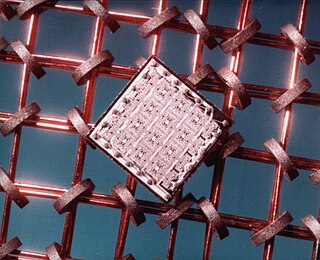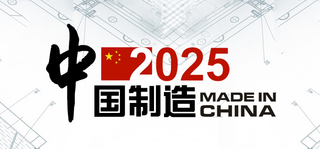
Dynamic random-access memory is a type of random-access semiconductor memory that stores each bit of data in a memory cell, usually consisting of a tiny capacitor and a transistor, both typically based on metal–oxide–semiconductor (MOS) technology. While most DRAM memory cell designs use a capacitor and transistor, some only use two transistors. In the designs where a capacitor is used, the capacitor can either be charged or discharged; these two states are taken to represent the two values of a bit, conventionally called 0 and 1. The electric charge on the capacitors gradually leaks away; without intervention the data on the capacitor would soon be lost. To prevent this, DRAM requires an external memory refresh circuit which periodically rewrites the data in the capacitors, restoring them to their original charge. This refresh process is the defining characteristic of dynamic random-access memory, in contrast to static random-access memory (SRAM) which does not require data to be refreshed. Unlike flash memory, DRAM is volatile memory, since it loses its data quickly when power is removed. However, DRAM does exhibit limited data remanence.

Micron Technology, Inc. is an American producer of computer memory and computer data storage including dynamic random-access memory, flash memory, and USB flash drives. It is headquartered in Boise, Idaho. Its consumer products, including the Ballistix line of memory modules, are marketed under the Crucial brand. Micron and Intel together created IM Flash Technologies, which produced NAND flash memory. It owned Lexar between 2006 and 2017.
Rambus Inc. is an American technology company that designs, develops and licenses chip interface technologies and architectures that are used in digital electronics products. The company, founded in 1990, is well known for inventing RDRAM and for its intellectual property-based litigation following the introduction of DDR-SDRAM memory.
The semiconductor industry is the aggregate of companies engaged in the design and fabrication of semiconductors and semiconductor devices, such as transistors and integrated circuits. It formed around 1960, once the fabrication of semiconductor devices became a viable business. The industry's annual semiconductor sales revenue has since grown to over $481 billion, as of 2018.

Mostek Corporation was a semiconductor integrated circuit manufacturer, founded in 1969 by L. J. Sevin, Louay E. Sharif, Richard L. Petritz and other ex-employees of Texas Instruments. At its peak in the late 1970s, Mostek held an 85% market share of the dynamic random-access memory (DRAM) memory chip market worldwide, until being eclipsed by lower-priced Japanese DRAM manufacturers who were accused of dumping memory on the market.

Semiconductor Manufacturing International Corporation (SMIC) is a partially state-owned publicly listed Chinese pure-play semiconductor foundry company. It is the largest contract chip maker in mainland China.

In 2002, the United States Department of Justice, under the Sherman Antitrust Act, began a probe into the activities of dynamic random-access memory (DRAM) manufacturers in response to claims by US computer makers, including Dell and Gateway, that inflated DRAM pricing was causing lost profits and hindering their effectiveness in the marketplace.

United Microelectronics Corporation is a Taiwanese company based in Hsinchu, Taiwan. It was founded as Taiwan's first semiconductor company in 1980 as a spin-off of the government-sponsored Industrial Technology Research Institute (ITRI).
Micron Memory Japan, K.K.(Japanese: マイクロンメモリジャパン株式会社, Micron Memory Japan Kabushiki-gaisha ) is a Japanese subsidiary of Micron Technology. It was formerly known as Elpida Memory, Inc. established in 1999 that developed, designed, manufactured and sold dynamic random-access memory (DRAM) products. It was also a semiconductor foundry. With headquarters in Yaesu, Chūō, Tokyo, Japan, it was initially formed under the name NEC Hitachi Memory in 1999 by the merger of the Hitachi and NEC DRAM businesses. In the following year it took on the name Elpida. In 2003, Elpida took over the Mitsubishi DRAM business. In 2004, it listed its shares in the first section of the Tokyo Stock Exchange. In 2012, those shares were delisted as a result of its bankruptcy. In 2013, Elpida was acquired by Micron Technology. On February 28, 2014, Elpida changed its name to Micron Memory Japan and Elpida Akita changed its name to Micron Akita, Inc.

Random-access memory is a form of electronic computer memory that can be read and changed in any order, typically used to store working data and machine code. A random-access memory device allows data items to be read or written in almost the same amount of time irrespective of the physical location of data inside the memory, in contrast with other direct-access data storage media, where the time required to read and write data items varies significantly depending on their physical locations on the recording medium, due to mechanical limitations such as media rotation speeds and arm movement.

High Bandwidth Memory (HBM) is a computer memory interface for 3D-stacked synchronous dynamic random-access memory (SDRAM) initially from Samsung, AMD and SK Hynix. It is used in conjunction with high-performance graphics accelerators, network devices, high-performance datacenter AI ASICs, as on-package cache in CPUs and on-package RAM in upcoming CPUs, and FPGAs and in some supercomputers. The first HBM memory chip was produced by SK Hynix in 2013, and the first devices to use HBM were the AMD Fiji GPUs in 2015.

Made in China 2025 is a national strategic plan and industrial policy of the Chinese Communist Party (CCP) to further develop the manufacturing sector of China, issued by CCP general secretary Xi Jinping and Chinese Premier Li Keqiang's cabinet in May 2015. As part of the Thirteenth and Fourteenth Five-year Plans, China aims to move away from being the "world's factory"—a producer of cheap low-tech goods facilitated by lower labour costs and supply chain advantages. The industrial policy aims to upgrade the manufacturing capabilities of Chinese industries, growing from labor-intensive workshops into a more technology-intensive powerhouse.
ChangXin Memory Technologies is a Chinese semiconductor integrated device manufacturer headquartered in Hefei, Anhui, specializing in the production of DRAM memory.

Yangtze Memory Technologies Corp (YMTC) is a Chinese semiconductor integrated device manufacturer specializing in flash memory (NAND) chips. Founded in Wuhan, China, in 2016, with government investment and a goal of reducing the country's dependence on foreign chip manufacturers, the company was formerly a subsidiary of partially state-owned enterprise Tsinghua Unigroup.

MOSAID is a semiconductor technology company incorporated in Ottawa, Canada. It was founded in 1975 as a DRAM design company, and later branched out into other areas including EDA software, semiconductor reverse engineering, test equipment manufacturing and intellectual property licensing. MOSAID went public in 1994 with a listing on the Toronto Stock Exchange under ticker symbol "MSD". By 2011 the business was based exclusively on patent licensing and the company was acquired by Sterling Partners, a US-based private equity firm. MOSAID was renamed Conversant Intellectual Property Management in 2013. In 2021, the company announced it was changing its name back to MOSAID.
The semiconductor industry, including Integrated Circuit (IC) manufacturing, design, and packaging, forms a major part of Taiwan's IT industry. Due to its strong capabilities in OEM wafer manufacturing and a complete industry supply chain, Taiwan has been able to distinguish itself as a leading microchip manufacturer and dominate the global marketplace. Taiwan’s semiconductor sector accounted for US$115 billion, around 20 percent of the global semiconductor industry. In sectors such as foundry operations, Taiwanese companies account for 50 percent of the world market, with Taiwan Semiconductor Manufacturing Company (TSMC) the biggest player in the foundry market.
The Chinese semiconductor industry, including integrated circuit design and manufacturing, forms a major part of mainland China's information technology industry.

Alliance Semiconductor Corporation was an American semiconductor company active from 1985 to 2006 and originally based in San Jose, California. The company specialized in the design and manufacture of dynamic random-access memory (DRAM) and static random-access memory (SRAM). It also designed the silicon for graphics accelerator chips, among other fields. In 2006, the company dissolved, its intellectual property and other assets sold to various companies.
In South Korea, the semiconductor industry has continued to grow since the 1980s due to the heavy use of semiconductors in computers and other devices. South Korea held a 17.7 percent share in the global semiconductor market in 2022, and continued to be the second largest in the world for the 10th consecutive year since 2013.










